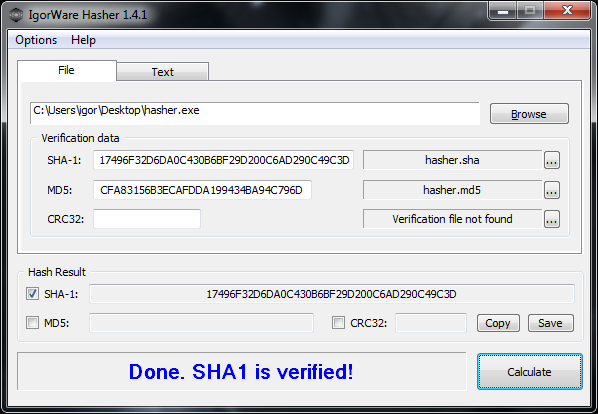
- File checksum integrity verifier install#
- File checksum integrity verifier code#
- File checksum integrity verifier iso#
Installing the package will prompt where to extract the utility. To verify the SHA1 hash of the ISO, you can download the File Checksum Integrity Verifier (fciv.exe) described in KB841290. This can help prevent issues when installing SP1.
File checksum integrity verifier iso#
If you downloaded the ISO for VS2010 SP1 from the Microsoft Download Center or from MSDN Subscriber Downloads, please verify the checksum for the ISO before you install.
File checksum integrity verifier install#
Fciv now stores full path or relatives paths.įciv 2.04: Removed several options to simplify it.įciv 2.05: Added success message if the verification did not detect any errors.While we recommend installing Visual Studio 2010 SP1 using the web download – which only downloads and install those packages needed on your machine – you can also download an ISO for offline use. When both alg are specified, it’s now done in one pass.įciv 2.03: Added -wp and -bp options.
File checksum integrity verifier code#
Added -both option.įciv 2.01: Exit with error code to allow detections of problem in a script.įciv 2.02: Improved perfs. *.exe *.dll …įciv 2.0: xml as unique storage. It checks each entry stored in the db and verify that the checksum was not modified.įciv 1.21: Fixed bad keyset error on some computers.įciv 1.22: Added -type option. You can build a hash database of your sensitive files and verify them regularily or when you suspect that your system To display the MD5 hash of a file, type fciv.exe filenameįciv.exe c:\ -r -exc exceptions.txt -sha1 -xml dbsha.xmlįciv.exe -v -bp c:\mydir -sha1 -xml db.xml xml db : Specify database format and name. md5 | -sha1 | -both : Specify hashtype, default md5. The base path is removed from the path name of each entry exc file: list of directories that should not be computed. add : Compute hash and send to output (default screen). – store filename with or without full path. – Exception list to specify files or directories that should not be computed. – Can recursively browse a directory ( ex fciv.exe c:\ -r ). – Display to screen or store hash and filename in a xml file. – Hash algorithm: MD5, SHA1 or both ( default MD5).

You can also schedule verifications regularily. When you suspect that your system has been compromised, you can run a verification to determine which files have been modified.

With fciv, you can compute hashes of all your sensitive files. If the file is modified, the hash is different. It computes a MD5 or SHA1 cryptographic hash of the content of the file. Microsoft (R) File Checksum Integrity Verifier V2.05 README fileġ.What is File Checksum Integrity Verifier (FCIV)?įciv is a command line utility that computes and verifies hashes of files. You can read more regarding that (unsupported) Microsoft tool at You can get FCIV from (after unpacking it at some folder you can checkout the tool parameters by typing fciv or fciv /? at the command line – of course you can use fciv | more to see the syntax page by page). Would be nice to have a GUI wrapper around that tool that would also cooperate with the task scheduler to run regular checks of sensitive files. I recently came across a very useful Microsoft tool (FCIV) that can compute and store (as XML) checksums (MD5, SHA1 or both hashes) of folders/files you want and can also be used to later on verify the checksum lists to see if they’ve been tampered with.


 0 kommentar(er)
0 kommentar(er)
